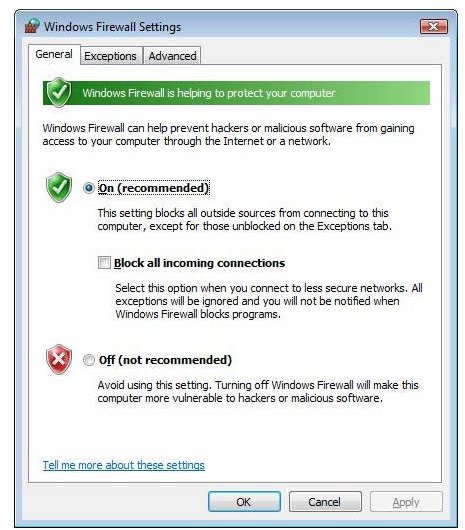Troubleshooting Windows Vista Networking Issues such as Windows Vista Network Dropout
Windows Vista’s Diagnose And Repair
Vista comes with a built-in tool that allows users to troubleshoot problems without getting into them in detail. The Diagnose and Repair feature is an easy way for IT Administrators or home users to solve the problem in a few steps. To make use of the feature, just open the Network and Sharing Centre and click on Diagnose and Repair on the sidebar. This tool will take you through the steps, check your network connections to find problems, and fix them.
Network Filtering
Vista has a built-in firewall. Its basic function is to filter data packets, letting the authorized ones go through and blocking the suspicious or unauthorized ones. Vista’s firewall is enabled by default and it is unlikely that it is blocking all network access. It is expected of it that it only block certain inbound or outbound network connections for specific applications. What you can do to check whether the firewall is causing your network problem or not is to disable it and then see if your problem is resolved. If it is, you can re-enable it and then troubleshoot it to find out which port you need the firewall to allow and disallow your network traffic through.
To disable/enable the Windows Firewall, go to Network and Sharing Centre then click on Turn Windows Firewall on or off. To add exceptions for the Windows Firewall, click on Windows Firewall inside the Network and Sharing Centre and click Change Settings to add/modify exceptions.

If you are also having difficulty accessing computers on your LAN, you can check your Network Discovery settings. To do this, go to Network and Sharing Centre scroll down to the Sharing and Discovery section. There you can check things like File Sharing, Network Discovery, Public folder sharing and others and make sure their settings are correct.
IP Addressing
If you have done the basic checks to identify the problem, but the problem has not been resolved, we can then look at something more advanced. At this stage, you need to check your IP addressing to ensure that your IP address is correct and matches your network and default gateway addresses. Also you will check you have DNS Server and default gateway IP addresses defined.
To do this, go to the Network and Sharing Centre and click on View status (assuming you have a connection). Now click on Details to see the IP address, subnet mask, default gateway and DNS Servers. If any of these are missing, this could be a good hint in your troubleshoot process as to why you have a network problem. Alternatively, you can also do IPCONFIG /ALL from Command Prompt to check all your IP settings. You should also ping DNS Server, default gateway to ensure you can actually communicate with them.
DHCP Broadcast Flag
If you have a DHCP server configured on your network and you see your Windows XP running computers working fine but only Vista computers cannot connect to your network, this is a problem related to the DHCP server broadcast flag setting. In Windows XP, the Broadcast flag is disabled whereas in Vista, the flag is enabled. This causes certain routers to fail in processing DHCP packets.
To disable the Broadcast flag, follow these steps:
Note: This works involves modifying Windows registry; serious problems might occur if you modify the registry incorrectly. Therefore, make sure you back up the registry or create a system restore point before attempting it.
1. Go to run and enter regedit (Ok)
2. Locate and then click this registry key: HKEY_LOCAL_MACHINE\SYSTEM\CurrentControlSet\Services\Tcpip\Parameters\Interfaces\{GUID}
3. In the registry path, click the (GUID) subkey that corresponds to the network adapter that is connected to the network.
4. Use the Edit menu, point to New, then click DWORD (32-bit) Value.
5. In the New Value #1 box, type DhcpConnEnableBcastFlagToggle, then press Enter.
6. Right-click DhcpConnEnableBcastFlagToggle, then click Modify.
7. In the Value data box, type 1, then click OK.
8. Close the Registry Editor.
Now, Windows Vista will first try to obtain an IP address, using the Broadcast flag in DHCP packets and if that is unsuccessful, it will try to obtain an IP address without using the Broadcast flag.
Miscellaneous Other Things To Check
There are many basic things that can be checked and these relate to common sense, really. You can check whether the network cable is connected or not, link light on the NIC, network cable connection, Ethernet switch power and a link light, etc. Outdated or incorrect device drivers are also often the cause for problems, so ensure your network card has updated drivers.
Microsoft has a large collection of question and answers you can look at that provides information about network troubleshooting in Windows Vista. Visit this information here.
